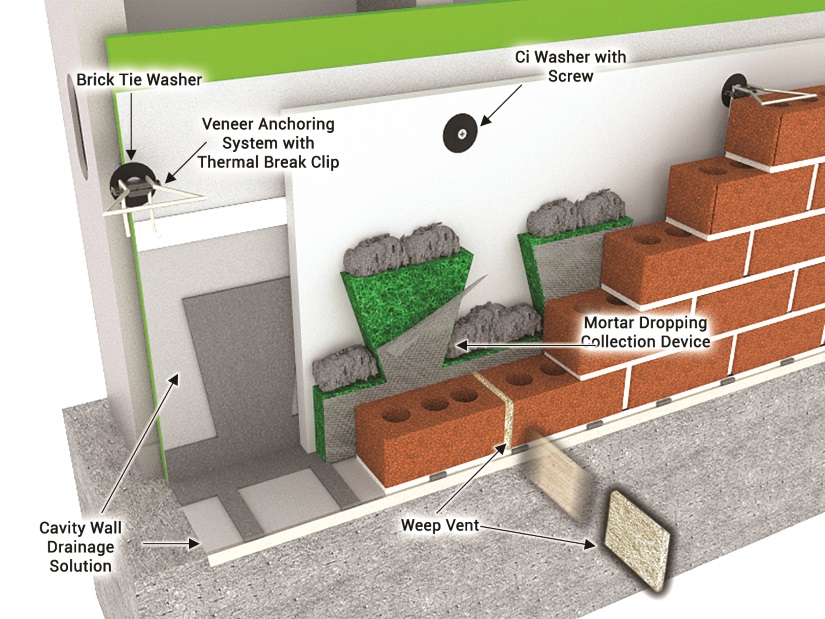Designing Adhered Masonry Veneer
Learning Objectives:
- List the similarities and differences between a cavity wall and an adhered masonry veneer.
- Explain the typical issues caused by improper installation of adhered masonry veneers.
- Define the products typically used in sustainable adhered masonry veneer walls.
- Describe installation techniques designed to improve the safety, durability, and long-term performance of adhered masonry veneer walls.
Credits:
This course explains the design of adhered masonry wall systems typical of today’s best practices. It utilizes familiar masonry cavity wall design to show why proper ventilation and drainage typical in this wall type must also be used in adhered masonry veneer wall design, and explores the design differences and similarities between masonry cavity wall systems and adhered masonry veneer systems. It shows the results of improper wall design, common errors in adhered masonry installation techniques and product selection, and the correct techniques and products necessary for constructing sustainable, energy-efficient adhered masonry veneer walls that will remain free of water damage for the life of the building.
At the end of this program, students will understand the proper construction of adhered masonry veneer walls. They will be familiar with how air and moisture move in and out of the wall, with all the components necessary for detailing a modern adhered masonry veneer wall system, and how to design a long-lasting wall that promotes proper water drainage and drying for the life of the wall. They will also have a more complete understanding of how to evaluate adhered masonry installations in the field so they can make sure their designs are properly executed and their clients are satisfied with the results.
AIA Sustainable Design Definition
The AIA defines sustainability as the concept of meeting present needs without compromising the ability of future generations to meet their own needs. AIA provides guidelines to help designers create sustainable designs, which include resource-efficient construction and processes; building with a minimal environmental impact; reducing waste, pollution, and overall environmental degradation; and providing for the protection and enhancement of occupant health and productivity.
Designers’ Challenge: Creating a Specification That Matches the Installation
Specifications are the guidebook for every project and are one of the most important documents in the construction industry. The specifier expects the specifications to be followed to the letter, resulting in a well-constructed, properly sourced, functional, and sustainable structure. What the specifications cannot do is teach a low bidder to install high-quality products with well-trained personnel if the bidder is trying to “value engineer” out key components or well-trained personnel are not available. This program will provide information about material function and installation that can be utilized to create high-performing, sustainable wall systems that conform to design expectations, no matter the contractor.
Masonry Cavity Wall Design
No masonry wall is waterproof. Water will penetrate the veneer due to differences in the path of moisture travel, varying absorbency of materials, and openings in the veneer that may develop during or after construction. Trapped moisture can create wall failures, callbacks, and damage to installer and designer reputations, so designing and building for rapid moisture removal and drying is vital for creating sustainable walls. Because the latest building science shows that adhered masonry walls can benefit by using the same proven design principles as those used in masonry cavity walls, it’s important to have an understanding of what makes cavity wall design so effective.

Image courtesy of Mortar Net Solutions
Masonry Cavity Wall with 1-inch rigid insulation and 1-inch cavity
Basic cavity wall design locates the inside face of the veneer one to several inches from the interior structure of the building and includes a drainage system, which consists of three key components.
The first is a flashing that extends up the substrate wall 10 to 12 inches and under the first or second course of exposed veneer above grade to the outside of the structure. A drip edge is often used to trim the appearance of the flashing, ensure that the flashing extends to the outside face of the veneer, and provide a hemmed lip to allow moisture to drip away from the veneer. The flashing must be level or sloped slightly toward the exterior to allow the water to drain to the outside.
The second is weep holes, the placement and function of which is so critical that they should be specified with as much care as the rest of the wall’s components. Most codes require that weep holes be placed a maximum of 24 inches on-center, and they should always be placed directly on clean flashing. Open weep holes are not recommended and should be filled with open cell or mesh weep vents that extend the full height of the head joint. These weep vent types are the best choice because they allow rapid drainage and air movement in and out of the cavity. Wick weeps are not recommended because they don’t allow air movement, and can deteriorate and fail to drain.
A mortar collection device is the final key component, as it prevents mortar droppings from reaching the flashing and clogging the weeps, while providing multiple pathways for moisture to flow around the droppings. With the drainage system in place and an open cavity, moisture can find its way to the base of the wall unrestricted, air can move in and out of the cavity, and the veneer, cavity, and substrate can dry rapidly and completely.









